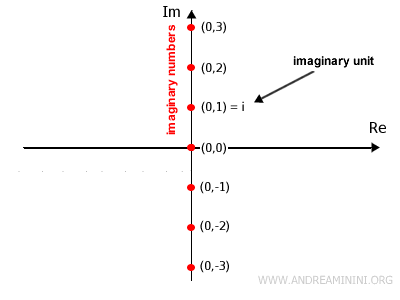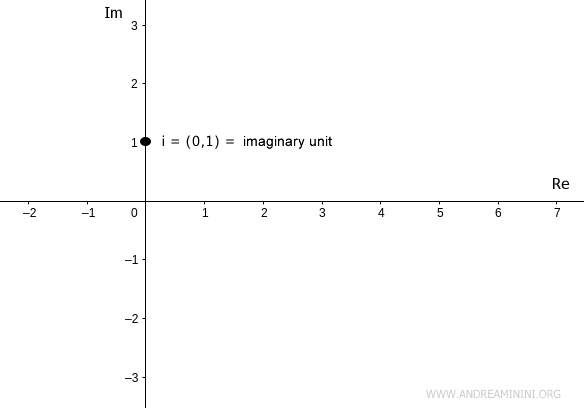Imaginary Numbers
An imaginary number is a complex number of the form \( (0,b) \), where the real part is zero. $$ (0,b) $$ or \( bi \) in algebraic form. $$ b \cdot i $$ Here, \( i \) represents the imaginary unit, defined as \( i = (0,1) \).
In essence, it’s a pair of real numbers where the first component is always zero.
Geometrically, the set of imaginary numbers corresponds to the points on the vertical axis (Im) of the Gaussian plane.

One particularly significant imaginary number is \( (0,1) \), known as the imaginary unit.
The Imaginary Unit
The imaginary unit is the imaginary number \( (0,1) \). It is commonly represented by the symbol \( i \) or \( j \). $$ i = (0,1) $$
Below, you can see the imaginary unit on the Gaussian plane.

Note. The imaginary unit is usually denoted by \( i \) in mathematical contexts and \( j \) in engineering. The meaning is identical in both cases: $$ i = j = (0,1) $$
The imaginary unit is crucial because its square equals -1.
$$ i^2 = (0,1)^2 = -1 $$
Proof. To demonstrate this, we calculate the square of the imaginary unit \( (0,1)^2 \) as the product of \( (0,1) \) with itself. $$ (0,1)^2 = (0,1) \cdot (0,1) $$ Perform the multiplication of these complex numbers: $$ (0,1)^2 = ( 0 \cdot 0 - 1 \cdot 1, 0 \cdot 1 + 1 \cdot 0 ) $$ $$ (0,1)^2 = ( 0 - 1, 0 + 0 ) $$ $$ (0,1)^2 = ( -1, 0 ) $$ The result is the real number \(-1\). Therefore, the square of the imaginary unit \( i = (0,1) \) is \( i^2 = -1 \).
This property is particularly useful when calculating the square roots of negative real numbers.
Example
The square root of -9 cannot be computed within the realm of real numbers:
$$ x = \sqrt{-9} $$
However, it can be solved using complex numbers:
$$ x = \sqrt{-1 \cdot 9} $$
Since \( i^2 = -1 \):
$$ x = \sqrt{i^2 \cdot 9} $$
$$ x = i \cdot \sqrt{9} $$
Now that the radicand is a positive real number, we can compute the square root:
$$ x = \pm i \cdot 3 $$
The solutions to \( \sqrt{-9} \) are the complex imaginary numbers \( 0 + 3i \) and \( 0 - 3i \), or \( (0,3) \) and \( (0,-3) \):
$$ x = \sqrt{-9} = \begin{cases} 0 + 3i \\ \\ 0 - 3i \end{cases} $$
These solutions are conjugate complex numbers.
Additional Properties of the Imaginary Unit
In general, multiplying the imaginary unit \( (0,1) \) by a real complex number \( (a,0) \) results in an imaginary number \( (0,a) \):
$$ (a,0) \cdot (0,1) = (0,a) $$
Proof. To prove this, perform the multiplication: $$ (a,0) \cdot (0,1) = (a \cdot 0 - 0 \cdot 1, a \cdot 1 + 0 \cdot 0) $$ $$ (a,0) \cdot (0,1) = (0 - 0, a + 0) $$ $$ (a,0) \cdot (0,1) = (0, a) $$
Example
Multiply the real complex number \( z_1 = (5,0) \) by the imaginary unit \( i = (0,1) \):
$$ z_1 \cdot i = (5,0) \cdot (0,1) $$ $$ z_1 \cdot i = (5 \cdot 0 - 0 \cdot 1, 5 \cdot 1 + 0 \cdot 0) $$ $$ z_1 \cdot i = (0 - 0, 5 + 0) $$ $$ z_1 \cdot i = (0, 5) $$
The result is an imaginary number.
A Practical Example
Consider two imaginary numbers:
$$ z_1 = (0,4) $$
$$ z_2 = (0,3) $$
The sum of these imaginary numbers is also imaginary:
$$ z_1 + z_2 = (0,4) + (0,3) = (0+0,4+3) = (0,7) $$
However, the product of two imaginary numbers is a real number:
$$ z_1 \cdot z_2 = (0,4) \cdot (0,3) $$
$$ z_1 \cdot z_2 = (0 \cdot 0 - 4 \cdot 3, 0 \cdot 3 + 4 \cdot 0) $$
$$ z_1 \cdot z_2 = (0 - 12, 0 + 0) $$
$$ z_1 \cdot z_2 = (-12, 0) $$
Imaginary Numbers in Algebraic Form
An imaginary number \( (0,b) \) can also be expressed in algebraic form as \( bi \), where \( i \) is the imaginary unit \( i = (0,1) \). $$ (0,b) = bi $$
Proof
Take any imaginary number \( (0,b) \):
$$ z = (0,b) $$
Express it in algebraic form:
$$ z = b \cdot i $$
Since \( i = (0,1) \):
$$ z = b \cdot i = b \cdot (0,1) $$
By calculating the multiplication, we retrieve the form \( (0,b) \):
$$ z = b \cdot i = b \cdot (0,1) = (b \cdot 0 , b \cdot 1) $$
Note. In algebraic form, imaginary numbers are handled similarly to monomials. However, they are not monomials, as the imaginary unit is a constant, not a variable.
Operations with Imaginary Numbers
The following rules apply to mathematical operations with imaginary numbers:
- Adding Imaginary Numbers
For two imaginary numbers \( z_1 = (0,a) \) and \( z_2 = (0,b) \), addition combines their imaginary coefficients: $$ z_1 + z_2 = (0,a) + (0,b) = (0,a+b) $$ Algebraically: $$ z_1 + z_2 = ai + bi = (a+b)i $$ - Subtracting Imaginary Numbers
For two imaginary numbers \( z_1 = (0,a) \) and \( z_2 = (0,b) \), subtraction finds the difference between their coefficients: $$ z_1 - z_2 = (0,a) - (0,b) = (0,a-b) $$ Algebraically: $$ z_1 - z_2 = ai - bi = (a-b)i $$ - Multiplying Imaginary Numbers
The product of \( z_1 = (0,a) \) and \( z_2 = (0,b) \) is a real number: $$ z_1 \cdot z_2 = (0,a) \cdot (0,b) = -ab $$ Algebraically: $$ z_1 \cdot z_2 = ai \cdot bi = ab i^2 = ab(-1) = -ab $$ - Dividing Imaginary Numbers
The division of \( z_1 = (0,a) \) by \( z_2 = (0,b) \) results in a real number: $$ (0,a) : (0,b) = (a:b, 0) $$ Algebraically: $$ ai : bi = a:b $$ - Raising Imaginary Numbers to a Power
Raising an imaginary number to a power multiplies the power of the real coefficient by the power of the imaginary unit: $$ (ai)^n = a^n \cdot i^n $$ The powers of \( i \) follow a periodic cycle: \( i^0 = 1 \), \( i^1 = i \), \( i^2 = -1 \), \( i^3 = -i \), and so on.
Note. Addition and subtraction are closed operations for imaginary numbers, as the result is always an imaginary number. However, multiplication and division are not closed, as their results are real numbers.
Additional Notes
Here are some extra insights about imaginary numbers:
- Zero is an imaginary number
Zero can be considered imaginary because it can be expressed as the product of zero and the imaginary unit: $$ 0 = 0 \cdot i $$ - Imaginary numbers are not monomials
While imaginary numbers behave like monomials in some operations (e.g., \( 4i + 3i = 7i \)), they are not monomials because \( i \) is a constant, not a variable.
And so on.
